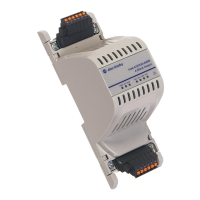Rockwell Automation Publication 1444-UM001D-EN-P - June 2018 313
Operate the Module Chapter 10
4…20 mA Output Status Indicators
Each status indicator represents the state of that particular channel or output.
Normal expected status indicator states for a healthy system are all solid green.
For each output (channel), if the output is not enabled, the associated status
indicator is off.
If enabled:
• Blue if the output is inhibited or the link is halted
• Red when the link fault output value is imposed by the expansion
module
• In either case, the output is likely being held static (same value
maintained)
Otherwise, the output status indicator is green.
The color is always solid, except all enabled channels flash the active color
during a link fault.
Table 81 - AOFX Status Indicators
Status
Indicator
Description OFF Green Blue Red Red/Green Blue/Green
Solid Flashing
(off)
Solid Flashing
(off)
Solid Flashing (off) Flashing Flashing
PWR Power status 5V power
not OK
5V power OK—— ——— — —
LNS Local network
status
Relay
module not
is configured
Configured
and bus OK
Configured
and bus NOT
OK
— ——— — —
MS Module status — — Processor
activity / OK
— Processor
warning
Processor
critical error
Processor
critical error
——
OP0 Output 0 status Output not
in use
Host
controlling
(1)
Bus fail Output state
that is held
(2)
Bus fail — Bus fail. Output
that is held at
fault indication
level
——
OP1 Output 1 status Output not
in use
Host
controlling
(1)
Bus fail Output state
that is held
(2)
Bus fail — Bus fail. Output
that is held at
fault indication
level
——
OP2 Output 2 status Output not
in use
Host
controlling
(1)
Bus fail Output state
that is held
(2)
Bus fail — Bus fail. Output
that is held at
fault indication
level
——
OP3 Output 3 status Output not
in use
Host
controlling
(1)
Bus fail Output state
that is held
(2)
Bus fail — Bus fail. Output
that is held at
fault indication
level
——
(1) Host controlling means that the module is receiving level data for output from its host module.
(2) Output is being held due to bus halt. Halt is where the expansion module is advised to extend its link timeout temporarily.

